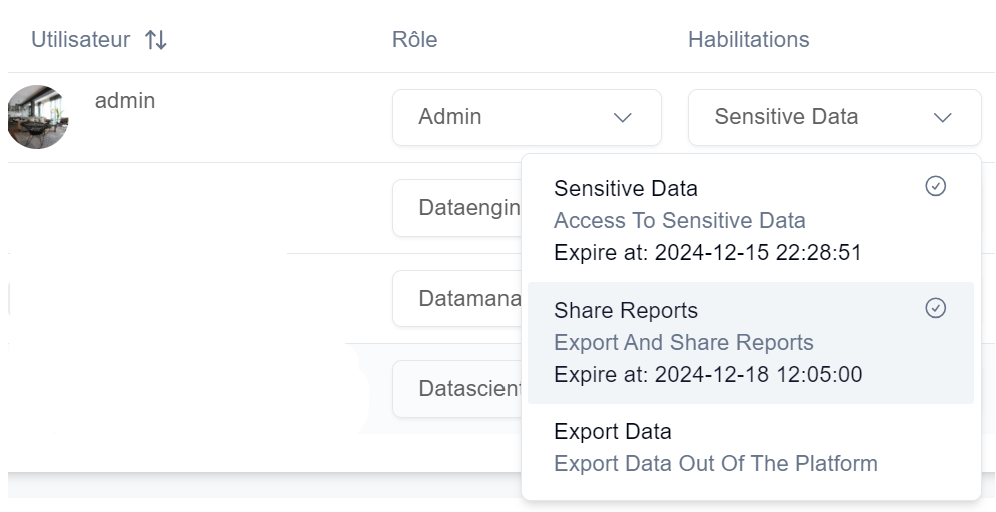User / Role / Authorization management
Authentication mode
Qalita Platform supports the following authentication modes:
- Password authentication : Users can authenticate themselves with a password and a user ID. This authentication can be set up to work with an enterprise directory using the ldap protocol.
Configuring LDAP
To configure LDAP authentication, you'll need to add environment variables to the backend.
LDAP_SERVER: The LDAP server addressldap://openldap:389LDAP_DN: The base DN for user searchesdc=example,dc=org.LDAP_TLS: Enable TLSfalseLDAP_SEARCH_USER: The search usercn=admin,dc=example,dc=org.LDAP_SEARCH_PASSWORD: The search user passwordadminpassword.LDAP_SEARCH_USER_FILTER: The search filter for users(&(objectClass=person)(uid=%s)).LDAP_SEARCH_GROUP_FILTER: The search filter for groups(&(objectClass=posixGroup)(memberUid=%s))LDAP_ROLE_MAPPING: The mapping of rolesadmin:cn=direction,dc=qalita,dc=io;dataengineer:cn=factory,dc=qalita,dc=io;datamanager:cn=conseil,dc=qalita,dc=io
- SSO authentication: Users can authenticate with an external identity provider (Google, Azure, Okta, etc...).
Configuring SSO
To configure SAML authentication, you will need to add environment variables to the Backend.
QALITA_AUTH_MODE: Specify the authentication mode assamlQALITA_SAML_AZURE_CLIENT_ID: The application's client ID (see #5-retrieve-application-details)QALITA_SAML_AZURE_CLIENT_SECRET: The application's client secret (see #5-retrieve-application-details)QALITA_SAML_AZURE_TENANT_ID: The application's tenant ID (see #5-retrieve-application-details)QALITA_SAML_AZURE_REDIRECT_URL: The application's redirection URLhttps://api.<qalita-domain>/api/v1/users/saml/callback
To create an application in Azure Active Directory (Azure AD) and configure SAML authentication for your platform, here is a step-by-step approach you can follow. This approach integrates into the process of configuring Single Sign-On (SSO) for your application, using Azure AD as the identity provider.
1. Access the Azure Portal
- Log in to the Azure Portal with your administrator account.
2. Navigate to Azure Active Directory
- In the Azure portal's sidebar, select "Azure Active Directory" to access your Azure AD directory.
3. Register a New Application
- Go to the "App registrations" section.
- Click on "New registration" to start the process of creating a new application.
- Name your application, select the supported account types, and specify the redirect URL (the callback URL used by your application after SAML authentication). This URL should match the
QALITA_SAML_AZURE_REDIRECT_URLyou will configure later in your environment variables.
4. Verify Authorized APIs
- Once the application is created, access it in the Azure portal.
- In the application's menu, look for the "API permissions" section.
- Click on "Add a permission" > "Microsoft Graph" > "Delegated permissions" > search for
User.Readand [Add permission]
5. Create an Application Secret
- Navigate to the "Certificates & secrets" section of your application.
- Click on "New client secret" to create a new application secret. You will need this secret to configure SAML authentication in your platform.
- Use the value to configure the
QALITA_SAML_AZURE_CLIENT_SECRETenvironment variable.
6. Retrieve Application Details
- After configuring SAML, you will need to retrieve several details to use in your environment variables:
- Client ID (
QALITA_SAML_AZURE_CLIENT_ID): Found in the application's "Overview" section. - Client Secret (
QALITA_SAML_AZURE_CLIENT_SECRET): You will need to create a secret for the application in the "Certificates & secrets" section. - Tenant ID (
QALITA_SAML_AZURE_TENANT_ID): Visible in the "Overview" section of your Azure Active Directory.
- Client ID (
7. Configure Environment Variables
- On your server or development environment, configure the environment variables you retrieved in the previous step.
8. Test SAML Authentication
- Test the SAML authentication to ensure everything is correctly configured and users can log in to your application via Azure AD.
By following these steps, you will have created an application in Azure AD, configured SAML authentication, and prepared your platform to use Azure AD as the identity provider for SSO authentication.
- Token authentication: Users can authenticate with an API token. (for the backend)
By default any user is assigned the public role on first login, unless a role mapping is specified in LDAP configuration.
Create a user
To create a user, go to the Users & Roles section of the Parameters menu.

The different roles

There are different roles in Qalita Platform that discriminate between possible actions and access rights.
| Role | Description | Authorizations |
|---|---|---|
| The administrator role gives access to all the platform's functionalities. | All | |
| The Dataengineer role has access to most of the platform's functionalities, except parameters and data science. | Agents - Packs - Sources - Projects - Reports - Tickets - Curation plan - Catalog | |
| The data manager role has access to project, report, ticket and curation plan functionalities. | Sources - Projects - Reports - Tickets - Curation plan - Catalog | |
| The data scientist role has access to catalog, report and data science functionalities. | Reports only with token - Catalog - Synthetic data - Model evaluation | |
| Profile - Notifications - Reports only with token | The public role has minimal access to the platform's functionalities. |
The different authorizations

There are different entitlements in Qalita Platform that allow you to grant rights to specific actions,
All authorizations have a lifetime (1 year by default).
| Habilitation | Description | Authorizations |
|---|---|---|
| Sensitive Data | The Sensitive Data habilitation allows access to sensitive data. | Sensitive Data |
| Share report | Share report enables you to share reports. | Share reports |